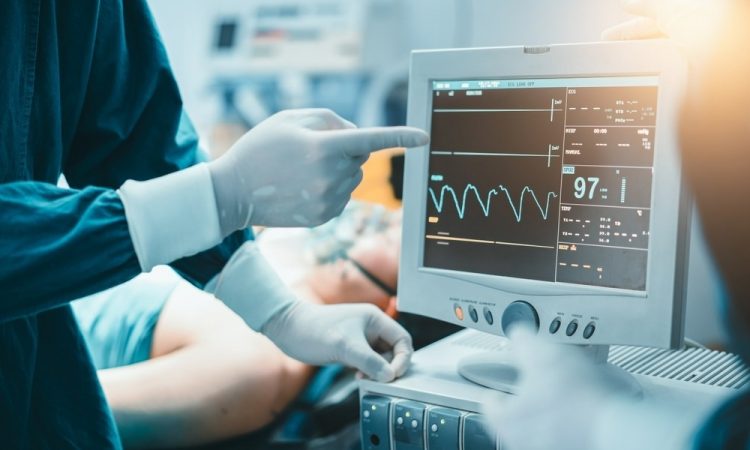Skin-friendly ECG sensor offers comfort without compromise on cardiac care

In a recent study published in Applied Physics Reviews, researchers optimized dry electrode geometries for a wearable electrocardiogram (ECG) patch to enhance its performance and comparability with commercial ECG monitors for remote and point-of-care (PoC) diagnostics.

Background
Rapid advances in medical tech spotlight wearable devices for uses from athletics to elder and neonatal care, especially with soaring healthcare costs. ECGs, vital for addressing cardiovascular diseases—a top global killer—rely traditionally on Silver/Silver Chloride (Ag/AgCl) 'wet electrodes,' which can irritate the skin. The emerging preference is for 'dry electrodes' without conductive gel.
Though materials like graphene and carbon nanotubes (CNTs) offer promise for wearables, concerns like toxicity and signal strength remain. Further research is needed to optimize electrode materials and configurations for effective, long-term ECG monitoring, especially for uninterrupted and remote use.
About the study
In a state-of-the-art ISO 5 class 1000 cleanroom, a new sensor was fabricated using the sophisticated Heidelberg 150 Advanced Maskless Aligner crucial for the lithography phase. The technique of traditional photolithography played a pivotal role in crafting the thin-film ECG sensor electrodes. The deployment of the AZ5214E photoresist was central to this fabrication. This specific substance, whose application can be found in additional resources, was carefully applied to polyimide films, and following this, a specific baking routine was executed.
In the selection of materials, gold (Au) stood out as the primary choice for the electrode, ensuring optimal signal transmission. To complement this, chromium (Cr) was introduced, serving as a bonding layer to ensure gold's steadfast adherence. During this phase, keen attention was paid to the layering process of both elements.
The objective was clear: achieving uniform thickness across the electrode. For protective purposes, the Allevyn Ag Gentle Border was chosen. This not only safeguarded the electrode but also contributed to its overall effectiveness.
The real-world application of this sensor was then tested in which a healthy 28-year-old male with no underlying heart issues volunteered. To guarantee the most genuine results, the environment was kept largely devoid of stress, introducing only specific, controlled stimuli. Before delving into the ECG test, thorough checks were conducted on the volunteer. Metrics such as weight, overall body composition, and fat percentage were evaluated to rule out any anomalies that might skew the ECG results.
A comparison was deemed necessary to validate this new sensor's effectiveness and accuracy. The well-regarded Hillrom Welch Allyn® wireless ECG device, equipped with a 12-electrode configuration, was used for this purpose. In another technical facet, the AD8232 component was intricately integrated with the Arduino 1.0.5 IDE.
This was done to ensure it perfectly complemented the newly developed ECG electrodes. Throughout this phase, stringent connectivity procedures were upheld, ensuring the gathered data was both accurate and representative of a variety of conditions.
Study results
The present study analyzed ECG signals, finding results influenced by electrode designs, body positioning, and various stimuli. Notably, the hexagonal labyrinth design excelled, demonstrating superior adaptability and consistent contact with the chest and neck. This design rivaled commercial ECG monitors and boasted superior skin conformity and lower resistance, enhancing signal capture. In the research, electrodes of this design were affixed using an Allevyn bandage, selected for its antimicrobial nature and ability to strengthen skin adherence.
The intricate workings of the heart were traced using these electrodes, capturing sequences like atrial and ventricular depolarization. With the three-lead wearable ECG sensor in this study, one can evaluate vital cardiac parameters such as the absence of P-wave, heart rate variability, and QT wave intervals.
Preliminary measurements involved a wired configuration connected to an AD8232 controlled by an Arduino Uno. When placed on the chest, the hexagonal labyrinth design sensor successfully captured high-quality signals across various postures and stimuli.
When interpreting ECG signals, it is essential to assess the temporal parameters. For instance, the PR segment viz period from the onset of the P wave (atrial depolarization) to the onset of the QRS complex (ventricular depolarization), reflecting impulse conduction through the atrioventricular node serves as the baseline for measuring any wave's amplitude.
Specific ranges were observed for the PR, QT, and ST waves viz the period between ventricular depolarization and repolarization when acquired through the hexagonal labyrinth electrodes, aiding in diagnosing potential cardiac anomalies.
In the study, the researchers presented findings regarding amplitude parameters for ECG measurements taken in lying-down postures using varied electrode designs. Specifically, they focused on the hexagonal labyrinth design, which showed that R-wave, a critical amplitude parameter, was around 0.22–0.23 mV.
Other key amplitude parameters like P, Q, and T-waves also showcased specific values. Slight deviations in the readings were expected due to the nature of ambulatory ECG measurements.
Using the hexagonal labyrinth design-based sensor, they extended their measurements to the neck region. Under various stimuli such as rest, physical stress, and combined physical and mental stress, the sensor successfully gathered high-quality signals, distinguishing between a state of rest and stress.
Furthermore, when analyzing time parameters from ECG signals, they discovered that various intervals, such as the PR, ST, and QT waves, had readings within standard ranges using their specific electrode design.
Comparative analysis was conducted with a standard 12-lead ECG monitor, and responses from the chest and neck regions matched with ideal ECG readings. This comparison highlighted the close correlation of certain parameters, with some deviations. They emphasized that such device-specific responses are vital during the development phase of ECG sensors.
Additionally, a commercial portable 12-lead ECG monitor, Welch Allyn®, was utilized for comparison. Observations indicated that while there were certain device-specific variations in measurements, the overall correlation remained consistent, especially when external stimuli were applied.
Concerning design, the developed ECG sensor was positioned as a potential wearable ECG sensor patch. It demonstrated advantages over the commercial device in terms of portability and weight, as the Welch Allyn device was bulkier and heavier. The study also highlighted differences in electrode materials and signal acquisition capabilities between the two devices.
Lastly, the team developed a prototype of a compact wearable wireless ECG sensor with the capability of continuous cardiac monitoring integrated with a Bluetooth module for seamless data transfer to a smartphone application.
- Peter Francis Mathew Elango, Shanmuga Sundar Dhanabalan, Md Rokunuzzaman Robel,et al. Dry electrode geometry optimization for wearable ECG devices. Appl. Phys. 2023. doi: https://doi.org/10.1063/5.0152554 https://pubs.aip.org/aip/apr/article/10/4/041408/2919081/Dry-electrode-geometry-optimization-for-wearable
Posted in: Device / Technology News | Medical Science News | Medical Research News
Tags: Chromium, Diagnostics, Electrode, Healthcare, Heart, Heart Rate, Lithography, Neck, Research, Skin, Stress

Written by
Vijay Kumar Malesu
Vijay holds a Ph.D. in Biotechnology and possesses a deep passion for microbiology. His academic journey has allowed him to delve deeper into understanding the intricate world of microorganisms. Through his research and studies, he has gained expertise in various aspects of microbiology, which includes microbial genetics, microbial physiology, and microbial ecology. Vijay has six years of scientific research experience at renowned research institutes such as the Indian Council for Agricultural Research and KIIT University. He has worked on diverse projects in microbiology, biopolymers, and drug delivery. His contributions to these areas have provided him with a comprehensive understanding of the subject matter and the ability to tackle complex research challenges.